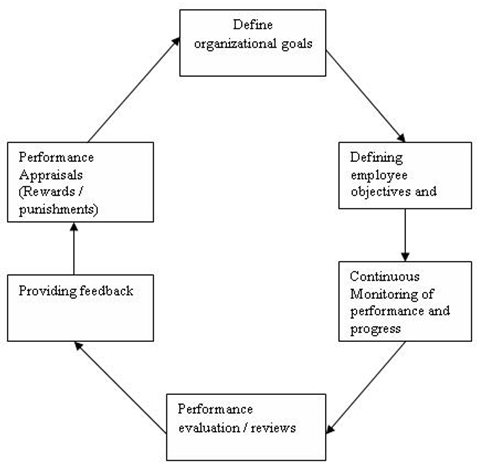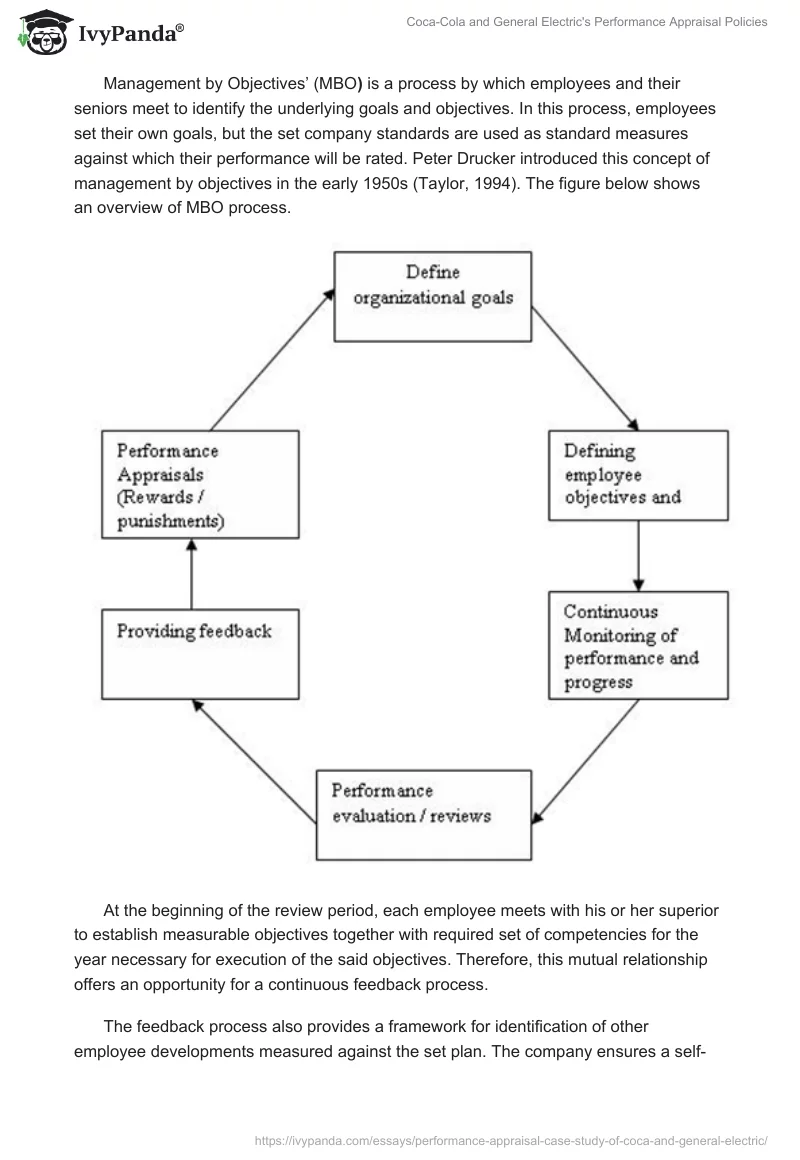Introduction
Performance appraisal is a systematic and continuous process that involves the rater and the ratee, where the former evaluates the performance of the later with respect to laid down standards (Bauer & Erdogan, 2009). During the performance review cycle, the evaluator constantly interacts and observes with the employee in order to establish his or her level of performance based on the company criteria.
Feedback is essential during this process to give the employee a vivid report with regard to achievement of objectives as initially set. This paper seeks to compare Coca-Cola and General Electric’s performance appraisal policies and examine their effectiveness. In 2011, GE emerged number six on fortune 500 companies according to fortune magazine. On the other hand, Coca-Cola attained the rank of 70 on this list of top 500 fortune companies based on revenues and profits (CNNMoney, 2011).
Analysis of Coca-Cola’s Employee Performance Appraisal
In Coca-Cola, performance management entails all programs designed for annual employee appraisal. This concerns procedures used in communicating work expectations and relaying of feedback on a continuous basis through yearly performance rating. Performance appraisal in Coca serves to promote and compensate employees among other management decisions (Bauer & Erdogan, 2009).
Management/Performance by Objectives (PBO)
The company has implemented a single performance appraisal system for all employees geared toward achieving fairness based on job-related metrics. The process implemented offers an opportunity for improvement in internal oversight as a means to achieve equal employment opportunity (EEO).
Management by Objectives’ (MBO) is a process by which employees and their seniors meet to identify the underlying goals and objectives. In this process, employees set their own goals, but the set company standards are used as standard measures against which their performance will be rated. Peter Drucker introduced this concept of management by objectives in the early 1950s (Taylor, 1994). The figure below shows an overview of MBO process.

At the beginning of the review period, each employee meets with his or her superior to establish measurable objectives together with required set of competencies for the year necessary for execution of the said objectives. Therefore, this mutual relationship offers an opportunity for a continuous feedback process.
The feedback process also provides a framework for identification of other employee developments measured against the set plan. The company ensures a self-drive assessment where employees communicate their progress to their superiors from which managers make exclusive evaluation based on the initial standards.
As a feedback oriented appraisal system, the management disseminated rating reports to the employees in which employees may appeal if need be (Taylor, 1994). To comply with the laid down best practices, Coca’s appraisal system involves a half-yearly employee review and mandatory training for two days where both managers and employees go through training on the functioning of the system. Employees work in conjunction with performance appraisal teams to plan, track and review their individual performance.
At the end of the review period, the top managers undergo training to provide fair and accurate rating. In addition, an independent rater works to offer separate ratings for employees based on the ongoing performance e valuation. This process ensures consistency and fairness in the process.
Purpose of the Performance system in Coca-Cola
The major essence of the appraisal system applied by Coca is to develop a set of employees who are aware of their duties, roles and responsibilities as expected of them by the company. The system thrives on the belief that clarity of objectives and continuous feedback lends an opportunity for achieving organizational and individual employee goals (Taylor, 1994).
Effectiveness of the system
MBO is a participatory process involving goal setting and selection of actions based on standard metrics in order to offer a basis for decision-making. Since the process involved in MBO is comparison of individual employee performance with the laid down organizational objectives, it follows that the process provides an objective evaluation for employee performance. An open-end feedback eminent in the process is likely to influence employees to fulfill their mandates.
Management by objectives thrives on features such as clarity of goals, effective communication, and motivation. According to research, where employees engage in the process of goal setting through an effective feedback oriented communication, they are more likely to offer best services aimed at meeting organizational as well as individual goals (Bauer & Erdogan, 2009). It is worth noting that since the process entails a vigorous and inclusive evaluation, it is highly likely to achieve fairness and accuracy of the overall outcome.
General Electric
General electric is one of the fortune 500 companies. It falls in a group of companies generally sought for employment by job seekers according to fortune magazine. General electric (GE) company employs forced ranking system of performance appraisal where the evaluator rates employees relative to other employees.
This process provides an overall evaluation of the employees, but not because of specific job descriptions and objectives (Bauer & Erdogan, 2009). During this process, the rater groups the employees into categories from excellent to worst, effective to ineffective based on laid down criteria. GE applies relative ranking and believes that it has the capacity to offer best criterion for achieving employee performance.
During the review cycle, the evaluator applies a method in which the upper cluster would have 20% of employees, 70% of employees would be in the middle, and the remaining 10% would be ranked at the bottom (Bauer & Erdogan, 2009). The former Chief Executive Officer of General Electric conceived this system.
According to GE, the technique helps to overcome leniency and errors of central tendency. Relative ranking do not use objective scale while assessing the effectiveness of the employees, but rather the performance evaluation of an employee depends on the entire group.
As a performance management system, relative ranking purports to generate a performance culture where the management declares intolerance to non-performance.
Purpose of the system
The major purpose of this performance system is to create a culture of performance while eliminating those employees with repeat performance problems. Through the ranking system, employees develop a tendency of performing better with an aim to achieve the set objectives. Forced ranking aims at eliminating errors associated with leniency and central tendency through grouping (Bauer & Erdogan, 2009).
Objectivity and effectiveness of Forced Ranking
Although the method is effective in communicating the need for good performance, it has several downsides. The process does not directly engage employee competencies through vivid feedback and as such, employees are not generally aware of their responsibilities. The raters solely discharge the evaluation process in usually one-sided performance appraisal procedure (Bauer & Erdogan, 2009).
Objectivity in this technique is impaired since individual performance does not find space as a basis for assessment. Despite the fact that the company communicates goals to its employees, there is no clear criterion to achieve objectivity of the entire process (Taylor, 1994). For a system to be objective, it must be able to offer a precise, clear and measurable metric upon which to measure employees.
However well employees perform, the system will always result in high and low ranks. This performance system fails to offer comparison for a diverse group. For instance, it is challenging to tell whether the third-ranked individual in department X is better than an individual ranked as third in department Y (Taylor, 1994). The system has inherent disadvantage of inability to create a spirit of teamwork and may lead to negative competition among employees.
References
Bauer, T., & Erdogan, B. (2009). Organizational Behavior. New York, NY: Flat World Knowledge.
CNNMoney. (2011). Fortune 500. Retrieved from https://money.cnn.com/magazines/fortune/fortune500/2011/full_list/
Taylor, C. (1994). Cultural diversity in organizations: theory, research, & practice. New York, NY: Berrett-Koehler Publishers.


